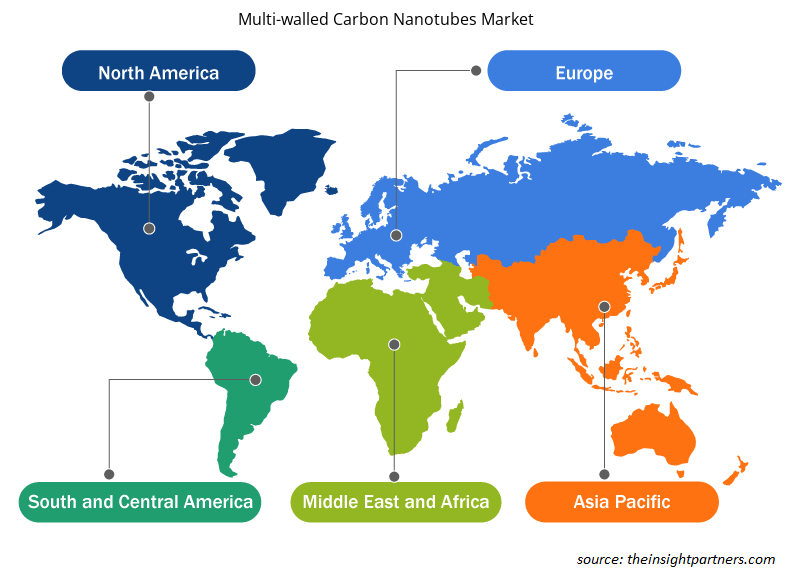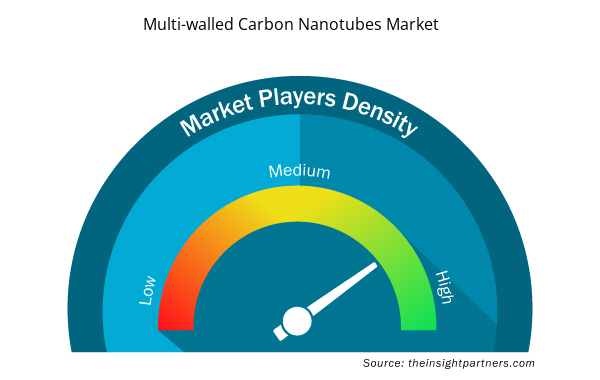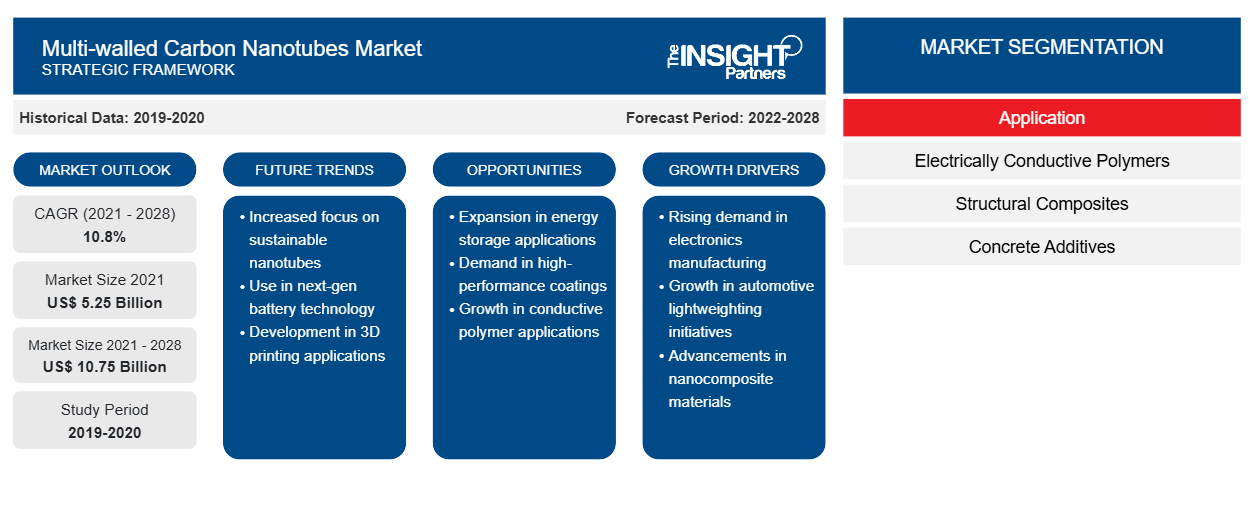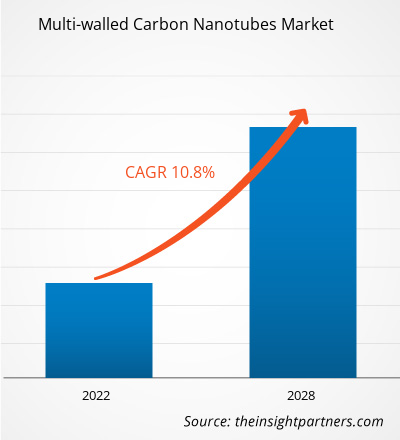Se espera que el tamaño del mercado de nanotubos de carbono de paredes múltiples crezca de 5.252,36 millones de dólares estadounidenses en 2021 a 10.748,27 millones de dólares estadounidenses en 2028. Se estima que aumentará a una CAGR del 10,8 % entre 2021 y 2028.nanotubes market size is expected to grow from US$ 5,252.36 million in 2021 to US$ 10,748.27 million by 2028. It is estimated to rise at a CAGR of 10.8% from 2021 to 2028.
Los nanotubos de carbono de pared múltiple (MWCNT) son una forma especial de nanotubos de carbono, en la que se encuentran múltiples nanotubos de carbono de pared simple uno dentro de otro. Las propiedades beneficiosas de los MWCNT han generado una gran demanda del producto en el mercado.
Personalice este informe según sus necesidades
Obtendrá personalización en cualquier informe, sin cargo, incluidas partes de este informe o análisis a nivel de país, paquete de datos de Excel, así como también grandes ofertas y descuentos para empresas emergentes y universidades.
- Obtenga las principales tendencias clave del mercado de este informe.Esta muestra GRATUITA incluirá análisis de datos, desde tendencias del mercado hasta estimaciones y pronósticos.
En 2020, América del Norte dominó el mercado mundial de nanotubos de carbono de paredes múltiples y se espera que mantenga su dominio durante el período de pronóstico. Estos nanotubos se utilizan ampliamente en electrónica, impulsando el mercado en América del Norte. Según la Comisión de Comercio Internacional de EE. UU., las exportaciones totales de productos electrónicos crecieron en US$ 7.9 mil millones (3%) a US$ 268 mil millones en 2017 en los EE. UU. Los productos electrónicos utilizan ampliamente nanotubos de carbono de paredes múltiples para fabricar chips, baterías, transistores y más. Se anticipa que la mayor demanda de productos electrónicos impulsará aún más el mercado en los próximos años. La presencia de actores líderes del mercado en la región está ayudando al crecimiento del mercado regional. Por ejemplo, en agosto de 2020, ChemSpec North America anunció que firmó un acuerdo de distribución no exclusiva con Nanocyl SA de Bélgica para promover y distribuir los productos de nanotubos de carbono de paredes múltiples (MWCNT) de Nanocyl.
Perspectivas del mercado
Ampliación de las aplicaciones de los nanotubos de carbono de paredes múltiples
La creciente aplicación de nanotubos de carbono de paredes múltiples en la industria aeroespacial y automotriz está impulsando el crecimiento del mercado. La disipación de calor en dispositivos electrónicos requiere materiales de interfaz con alta conductividad térmica. Por lo tanto, se están diseñando nanomateriales basados en carbono, como nanotubos de carbono de paredes múltiples, y se utilizan cada vez más para mejorar las propiedades térmicas, eléctricas y mecánicas. Los nanotubos de carbono de paredes múltiples se utilizan ampliamente en las industrias electrónicas como materiales para sensores de presión debido a sus diversas características, como la conductividad eléctrica y térmica, las propiedades magnéticas y la resistencia mecánica.nanotubes in the aerospace and automotive industry is driving the market growth. Heat dissipation in electronic devices requires interface materials with high thermal conductivity. Therefore carbon-based nanomaterials, such as multi-walled carbon nanotubes, are being designed and are increasingly used to boost the thermal, electrical, and mechanical properties. Multi-walled carbon nanotubes are being extensively used in electronic industries as sensor materials for pressure due to their several characteristics, such as electrical and thermal conductivity, magnetic properties, and mechanical strength.
Información sobre aplicaciones
Según la aplicación, el mercado de nanotubos de carbono de paredes múltiples se segmenta en polímeros conductores de electricidad , compuestos estructurales, aditivos para hormigón, baterías, investigación y desarrollo, entre otros. El segmento de baterías dominó la cuota de mercado en 2020. Se espera que sea el segmento de más rápido crecimiento en el mercado durante el período de pronóstico. El segmento de polímeros conductores de electricidad es el segundo segmento más grande en el mercado de nanotubos de carbono de paredes múltiples.nanotubes market is segmented into electrically nanotubes market.
Arkema; Showa Denko KK; Hyperion Catalysis International; Klean Industries; Kumho Petrochemical; LG Chem; Nanocyl SA; Ossila Ltd; Raymor Industries Inc; Tokyo Chemical Industry Co. Ltd.; Ocsial; Eden Innovations Ltd.; y Beyond Pacific Holdings, LLC son los actores clave que operan en el mercado de nanotubos de carbono de paredes múltiples. Los actores líderes adoptan varias estrategias, como fusiones y adquisiciones y lanzamientos de productos, para expandir su presencia geográfica y su base de consumidores. ; Showa Denko KK; Hyperion Catalysis International; Klean Industries; Kumho Petrochemical; LG Chem; Nanocyl SA; Ossila Ltd; Raymor Industries Inc; Tokyo Chemical Industry Co. Ltd.; Ocsial; Eden Innovations Ltd.; and Beyond Pacific Holdings, LLC are the key players operating in the multi-walled carbon nanotubes market. Leading players adopt several strategies, such as mergers & acquisitions and product launches, to expand their geographic presence and consumer base.
Nanotubos de carbono de paredes múltiplesNanotubes
Perspectivas regionales del mercado de nanotubos de carbono de paredes múltiplesNanotubes Market Regional Insights
Los analistas de Insight Partners explicaron en detalle las tendencias y los factores regionales que influyen en el mercado de nanotubos de carbono de paredes múltiples durante el período de pronóstico. Esta sección también analiza los segmentos y la geografía del mercado de nanotubos de carbono de paredes múltiples en América del Norte, Europa, Asia Pacífico, Oriente Medio y África, y América del Sur y Central.

- Obtenga datos regionales específicos para el mercado de nanotubos de carbono de paredes múltiples
Alcance del informe de mercado de nanotubos de carbono de paredes múltiples
| Atributo del informe | Detalles |
|---|---|
| Tamaño del mercado en 2021 | 5.250 millones de dólares estadounidenses |
| Tamaño del mercado en 2028 | US$ 10,75 mil millones |
| CAGR global (2021-2028) | 10,8% |
| Datos históricos | 2019-2020 |
| Período de pronóstico | 2022-2028 |
| Segmentos cubiertos | Por aplicación
|
| Regiones y países cubiertos | América del norte
|
| Líderes del mercado y perfiles de empresas clave |
|
Densidad de actores del mercado de nanotubos de carbono de paredes múltiples: comprensión de su impacto en la dinámica empresarial
El mercado de nanotubos de carbono de paredes múltiples está creciendo rápidamente, impulsado por la creciente demanda de los usuarios finales debido a factores como la evolución de las preferencias de los consumidores, los avances tecnológicos y una mayor conciencia de los beneficios del producto. A medida que aumenta la demanda, las empresas amplían sus ofertas, innovan para satisfacer las necesidades de los consumidores y aprovechan las tendencias emergentes, lo que impulsa aún más el crecimiento del mercado.
La densidad de actores del mercado se refiere a la distribución de las empresas o firmas que operan dentro de un mercado o industria en particular. Indica cuántos competidores (actores del mercado) están presentes en un espacio de mercado determinado en relación con su tamaño o valor total de mercado.
Las principales empresas que operan en el mercado de nanotubos de carbono de paredes múltiples son:
- Innovaciones Eden Ltd.
- Arcama
- SHOWA DENKO KK
- Catálisis Hyperion Internacional Inc.
- Industrias Klean Inc.
Descargo de responsabilidad : Las empresas enumeradas anteriormente no están clasificadas en ningún orden particular.

- Obtenga una descripción general de los principales actores clave del mercado de nanotubos de carbono de paredes múltiples
Informe Destacado
- Tendencias progresivas en la industria de nanotubos de carbono de paredes múltiples para ayudar a los actores a desarrollar estrategias efectivas a largo plazo
- Estrategias de crecimiento empresarial adoptadas por las empresas para asegurar el crecimiento en los mercados desarrollados y en desarrollo
- Análisis cuantitativo del mercado de nanotubos de carbono multipared de 2019 a 2028
- Análisis de Porters para ilustrar la eficacia de los compradores y proveedores que operan en la industria de los nanotubos de carbono de paredes múltiples
- Avances recientes para comprender el escenario competitivo del mercado y la demanda de nanotubos de carbono de paredes múltiples
- Tendencias y perspectivas del mercado junto con los factores que rigen el crecimiento del mercado de nanotubos de carbono de paredes múltiples
- Comprensión de las estrategias que sustentan el interés comercial sobre el crecimiento del mercado, ayudando en el proceso de toma de decisiones.
- Tamaño del mercado de nanotubos de carbono de paredes múltiples en varios nodos del mercado
- Descripción detallada y segmentación del mercado de nanotubos de carbono de paredes múltiples, así como su dinámica industrial
- Tamaño del mercado de nanotubos de carbono de paredes múltiples en varias regiones con oportunidades de crecimiento prometedoras
El "Análisis del mercado global de nanotubos de carbono de paredes múltiples hasta 2028" es un estudio especializado y profundo de la industria de bienes de consumo, que se centra en el análisis de las tendencias del mercado. El informe tiene como objetivo proporcionar una descripción general del mercado con una segmentación detallada del mercado. El mercado de nanotubos de carbono de paredes múltiples se analiza en función de la aplicación y la geografía. Según la aplicación, el mercado es de polímeros conductores de electricidad, compuestos estructurales, aditivos para hormigón, baterías, investigación y desarrollo, y otros. Según la geografía, el mercado está segmentado en cinco regiones principales: América del Norte, Europa, Asia Pacífico (APAC), América del Sur y Central (SCAM) y Oriente Medio y África (MEA). Se espera que América del Norte sea el segmento de más rápido crecimiento en el mercado de nanotubos de carbono de paredes múltiples, seguido de Asia Pacífico.
La creciente presencia de fabricantes globales y las crecientes industrias de uso final, como la automotriz y la aeroespacial, están impulsando la demanda de nanotubos de carbono de paredes múltiples en América del Norte. Estados Unidos tiene uno de los mercados automotrices más grandes del mundo. En 2018, las ventas de vehículos ligeros en Estados Unidos alcanzaron los 17,2 millones de unidades, el cuarto año consecutivo en el que las ventas alcanzaron o superaron los 17 millones de unidades. El aumento de la producción de automóviles en Estados Unidos está impulsando la demanda de nanotubos de carbono de paredes múltiples.
Perfiles de empresas
- Arcama
- Showa Denko KK
- Catálisis Hyperion Internacional
- Industrias Klean
- Petroquímica Kumho
- LG Química
- Nanociclo SA
- Ossila Ltd
- Industrias Raymor Inc.
- Compañía Industrial Química de Tokio Ltd.
- Ocsial
- Innovaciones Eden Ltd.
- Más allá de Pacific Holdings, LLC
- Análisis histórico (2 años), año base, pronóstico (7 años) con CAGR
- Análisis PEST y FODA
- Tamaño del mercado Valor/volumen: global, regional, nacional
- Industria y panorama competitivo
- Conjunto de datos de Excel


- Ketogenic Diet Market
- Gas Engine Market
- Smart Grid Sensors Market
- Biopharmaceutical Tubing Market
- Constipation Treatment Market
- Health Economics and Outcome Research (HEOR) Services Market
- Sterilization Services Market
- Rare Neurological Disease Treatment Market
- Influenza Vaccines Market
- Dealer Management System Market

Report Coverage
Revenue forecast, Company Analysis, Industry landscape, Growth factors, and Trends

Segment Covered
This text is related
to segments covered.

Regional Scope
North America, Europe, Asia Pacific, Middle East & Africa, South & Central America

Country Scope
This text is related
to country scope.
Preguntas frecuentes
The major players operating in the global MWCNTs market are Arkema; Showa Denko KK; Hyperion Catalysis International; Klean Industries; Kumho Petrochemical; LG Chem; Nanocyl SA; Ossila Ltd; Raymor Industries Inc; Tokyo Chemical Industry Co. Ltd.; Ocsial; Eden Innovations Ltd.; and Beyond Pacific Holdings, LLC. among many others.
Multi-walled carbon nanotubes are widely used in medicine and pharmaceutical industry for sensitive detection of essential biological components, precise and safer imaging of unhealthy tissues, and innovative treatments because of their mechanical, optical, electrical, and chemical properties. MWCNTs have outstanding electrical and mechanical properties, making them suitable for electronic applications. Thus, the growing demand for MWCNT from the healthcare and electronics sector is projected to offer lucrative opportunities for multiwalled carbon nanotubes in global market.
Silicon anodes for Li-ion batteries can be reinforced with MWCNTs to reduce their resistance, making them resilient to cracking and its effects during hundreds and thousands of charge/discharge cycles.
Multi-walled carbon nanotubes have been used and studied extensively as polymer additives to increase mechanical characteristics and features, fire retardancy, electromagnetic shielding, and thermal conductivity. Polymer composite producers buy the bulk of commercially generated MWCNTs, which are utilized in end-user products, including golf clubs, boat hulls, and structural plastics.
Multiwalled carbon nanotubes have high electrical conductivity and are used in conductive nano inks, battery cathodes, enhanced structural composites, thermal interface materials, and other applications. Thus, the expanding applications of MWCNTs boost the market growth. Moreover, li-ion batteries help reduce recharging time, boost tensile strength, and reduce vehicle weight. These benefits increase the applications of MWCNTs in the automobile industry, thereby driving market growth.
North America accounted for the largest share of the global MWCNTs market due to a wide range of commercialized applications for CNT, coupled with rising R&D activities to find new applications. The presence of leading companies in the region is aiding the market in North America.
Trends and growth analysis reports related to Chemicals and Materials : READ MORE..
The List of Companies - Multi-walled Carbon Nanotubes Market
- Eden Innovations Ltd.
- Arkema
- SHOWA DENKO K.K.
- Hyperion Catalysis International Inc.
- Klean Industries Inc.
- Kumho Petrochemical Co., Ltd.
- LG Chem
- Nanocyl SA
- Ossila Ltd.
- Raymor Industries Inc.
The Insight Partners performs research in 4 major stages: Data Collection & Secondary Research, Primary Research, Data Analysis and Data Triangulation & Final Review.
- Data Collection and Secondary Research:
As a market research and consulting firm operating from a decade, we have published and advised several client across the globe. First step for any study will start with an assessment of currently available data and insights from existing reports. Further, historical and current market information is collected from Investor Presentations, Annual Reports, SEC Filings, etc., and other information related to company’s performance and market positioning are gathered from Paid Databases (Factiva, Hoovers, and Reuters) and various other publications available in public domain.
Several associations trade associates, technical forums, institutes, societies and organization are accessed to gain technical as well as market related insights through their publications such as research papers, blogs and press releases related to the studies are referred to get cues about the market. Further, white papers, journals, magazines, and other news articles published in last 3 years are scrutinized and analyzed to understand the current market trends.
- Primary Research:
The primarily interview analysis comprise of data obtained from industry participants interview and answers to survey questions gathered by in-house primary team.
For primary research, interviews are conducted with industry experts/CEOs/Marketing Managers/VPs/Subject Matter Experts from both demand and supply side to get a 360-degree view of the market. The primary team conducts several interviews based on the complexity of the markets to understand the various market trends and dynamics which makes research more credible and precise.
A typical research interview fulfils the following functions:
- Provides first-hand information on the market size, market trends, growth trends, competitive landscape, and outlook
- Validates and strengthens in-house secondary research findings
- Develops the analysis team’s expertise and market understanding
Primary research involves email interactions and telephone interviews for each market, category, segment, and sub-segment across geographies. The participants who typically take part in such a process include, but are not limited to:
- Industry participants: VPs, business development managers, market intelligence managers and national sales managers
- Outside experts: Valuation experts, research analysts and key opinion leaders specializing in the electronics and semiconductor industry.
Below is the breakup of our primary respondents by company, designation, and region:

Once we receive the confirmation from primary research sources or primary respondents, we finalize the base year market estimation and forecast the data as per the macroeconomic and microeconomic factors assessed during data collection.
- Data Analysis:
Once data is validated through both secondary as well as primary respondents, we finalize the market estimations by hypothesis formulation and factor analysis at regional and country level.
- Macro-Economic Factor Analysis:
We analyse macroeconomic indicators such the gross domestic product (GDP), increase in the demand for goods and services across industries, technological advancement, regional economic growth, governmental policies, the influence of COVID-19, PEST analysis, and other aspects. This analysis aids in setting benchmarks for various nations/regions and approximating market splits. Additionally, the general trend of the aforementioned components aid in determining the market's development possibilities.
- Country Level Data:
Various factors that are especially aligned to the country are taken into account to determine the market size for a certain area and country, including the presence of vendors, such as headquarters and offices, the country's GDP, demand patterns, and industry growth. To comprehend the market dynamics for the nation, a number of growth variables, inhibitors, application areas, and current market trends are researched. The aforementioned elements aid in determining the country's overall market's growth potential.
- Company Profile:
The “Table of Contents” is formulated by listing and analyzing more than 25 - 30 companies operating in the market ecosystem across geographies. However, we profile only 10 companies as a standard practice in our syndicate reports. These 10 companies comprise leading, emerging, and regional players. Nonetheless, our analysis is not restricted to the 10 listed companies, we also analyze other companies present in the market to develop a holistic view and understand the prevailing trends. The “Company Profiles” section in the report covers key facts, business description, products & services, financial information, SWOT analysis, and key developments. The financial information presented is extracted from the annual reports and official documents of the publicly listed companies. Upon collecting the information for the sections of respective companies, we verify them via various primary sources and then compile the data in respective company profiles. The company level information helps us in deriving the base number as well as in forecasting the market size.
- Developing Base Number:
Aggregation of sales statistics (2020-2022) and macro-economic factor, and other secondary and primary research insights are utilized to arrive at base number and related market shares for 2022. The data gaps are identified in this step and relevant market data is analyzed, collected from paid primary interviews or databases. On finalizing the base year market size, forecasts are developed on the basis of macro-economic, industry and market growth factors and company level analysis.
- Data Triangulation and Final Review:
The market findings and base year market size calculations are validated from supply as well as demand side. Demand side validations are based on macro-economic factor analysis and benchmarks for respective regions and countries. In case of supply side validations, revenues of major companies are estimated (in case not available) based on industry benchmark, approximate number of employees, product portfolio, and primary interviews revenues are gathered. Further revenue from target product/service segment is assessed to avoid overshooting of market statistics. In case of heavy deviations between supply and demand side values, all thes steps are repeated to achieve synchronization.
We follow an iterative model, wherein we share our research findings with Subject Matter Experts (SME’s) and Key Opinion Leaders (KOLs) until consensus view of the market is not formulated – this model negates any drastic deviation in the opinions of experts. Only validated and universally acceptable research findings are quoted in our reports.
We have important check points that we use to validate our research findings – which we call – data triangulation, where we validate the information, we generate from secondary sources with primary interviews and then we re-validate with our internal data bases and Subject matter experts. This comprehensive model enables us to deliver high quality, reliable data in shortest possible time.


 Obtenga una muestra gratuita de este informe
Obtenga una muestra gratuita de este informe